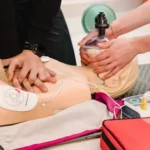Several drugs are administered when it comes to ACLS (Advanced Cardiovascular Life Support). The drugs for bradycardia include atropine and epinephrine. Atropine blocks the action of acetylcholine and increases the rate of heart. It’s given as an initial dose of 0.5 to 1 mg, with a maximum of 3 mg. If atropine fails, epinephrine is used. Epinephrine stimulates the heart and increases blood pressure.
In bradycardia situations, ACLS guidelines suggest administering 2 to 10 mcg/min of epinephrine via IV infusion. ACLS drugs for bradycardia improve heart rate and cardiac output in emergency settings. So, let us explore more about the role of these drugs and the protocols to be followed while administering them.
What are ACLS drugs and their role in managing bradycardia?
ACLS medications or drugs administered during Advanced Cardiovascular Life support interventions to manage life-threatening cardiac events such as bradycardia. Let us explore their roles further:
| Drug | Role |
| Atropine | Increases heart rate by blocking acetylcholine receptors. |
| Epinephrine | Stimulates the heart and increases blood pressure. |
| Dopamine | Increases heart rate and blood pressure. |
| Dobutamine | Increases heart contractility and rate. |
| Isoproterenol | Increases heart rate and contractility. |
How does atropine work in treating bradycardia during ACLS interventions?
Atropine is a key medication used during ACLS interventions to address bradycardia because it increases heart rate through specific mechanisms. Let us see how atropine works in treating bradycardia during ACLS interventions:
- Atropine blocks acetylcholine receptors in the heart.
- By blocking these receptors, atropine inhibits the parasympathetic nervous system’s influence on the heart.
- This inhibition leads to increased heart rate and improved conduction through the atrioventricular node.
- This helps to alleviate bradycardia by enhancing the heart’s rate and rhythm.
What is the recommended dosage of atropine for bradycardia in ACLS protocols?
In ACLS protocols, the recommended dosage of atropine for bradycardia starts with an initial dose of 0.5 to 1 milligram. Repeat the initial dose of atropine every 3 to 5 minutes where a maximum cumulative dose of 3 milligrams is given. It’s important to monitor the patient’s response very closely so that you can adjust the dosage as needed based on their condition and symptoms. Atropine is given intravenously and it plays a crucial role in increasing heart rate during ACLS interventions for bradycardia.
When is atropine indicated as the initial drug therapy for bradycardia in ACLS algorithms?
Atropine serves as the initial drug therapy for bradycardia in ACLS algorithms under specific circumstances. Let us understand when its administration is indicated as initial drug therapy.
| Situation | Indication for Atropine |
| Bradycardia causes hemodynamic instability or symptoms like hypotension or altered mental status | Yes |
| Symptomatic bradycardia, presenting with chest pain, shortness of breath, or signs of poor perfusion | Yes |
| Evidence of vagal response contributing to bradycardia, such as during vasovagal syncope or after vagal maneuvers | Yes |
| Bradycardia due to heart block increased vagal tone, or sinus node dysfunction | Yes |
What medications besides atropine are used in ACLS protocols for bradycardia?
In addition to atropine, other medications are also used in ACLS protocols to manage bradycardia effectively. These include:
- Epinephrine
- Dopamine
- Dobutamine
- Isoproterenol
Read more: How long is my ACLS/PALS certification good for?
How does dobutamine contribute to managing bradycardia in ACLS scenarios?
Dobutamine plays a significant role in managing bradycardia within ACLS scenarios by its specific actions on the heart. Here is how
Mechanism of Action:
Dobutamine stimulates beta1 adrenergic receptors and increases heart contractility and rate.
Indications in ACLS Protocols:
Dobutamine is used when bradycardia persists despite initial interventions or when there’s evidence of impaired cardiac contractility contributing to the bradycardia.
What are the key considerations and guidelines for administering ACLS drugs in bradycardia cases?
Administering ACLS drugs in bradycardia cases requires adherence to specific considerations and guidelines for safe and effective treatment. Key Considerations and Guidelines include:
Patient Assessment and Monitoring:
Thoroughly assess vital signs and continuously monitor response to treatment.
Drug Selection and Dosage:
Select appropriate drugs and administer them at recommended doses.
Route of Administration:
Use the correct route (usually IV) for rapid action.
Potential Adverse Effects:
Be vigilant for adverse reactions and intervene promptly.
Reassessment and Reevaluation:
Regularly reassess response and adjust treatment as needed.
Read more: Elements of Effective Team Dynamics in ACLS
Conclusion:
Effective management of bradycardia in ACLS scenarios relies on a proper and careful understanding of patient needs along with following the established guidelines. By assessing vital signs, selecting the right medications, and monitoring closely for adverse effects, healthcare providers can ensure safe and timely interventions. Next, regular reassessment allows for adjustments to treatment as necessary. It improves outcomes for patients who experience bradycardia during emergencies. So, with proper adherence to protocols, ACLS drugs for bradycardia play a vital role in restoring normal heart function and preserving patient well-being.
Resources:
https://www.ncbi.nlm.nih.gov/books/NBK470551/
https://www.ncbi.nlm.nih.gov/books/NBK493201/
https://www.ncbi.nlm.nih.gov/pmc/articles/PMC10063742/






